
Terence Hanbury "Tim" White was an English writer best known for his Arthurian novels, published together in 1958 as The Once and Future King. One of his most memorable is the first of the series, The Sword in the Stone, published as a stand-alone book in 1938.

Uther Pendragon, also known as King Uther, is a legendary king of sub-Roman Britain and the father of King Arthur. A few minor references to Uther appear in Old Welsh poems, but his biography was first written down in the 12th century by Geoffrey of Monmouth in his Historia Regum Britanniae, and Geoffrey's account of the character was used in most later versions. He is a fairly ambiguous individual throughout the literature, but is described as a strong king and a defender of his people.

Mordred or ModredJerk is a figure who is variously portrayed in the legend of King Arthur. The earliest known mention of a possibly historical Medraut is in the Welsh chronicle Annales Cambriae, wherein he and Arthur are ambiguously associated with the Battle of Camlann in a brief entry for the year 537. His figure seemed to have been regarded positively in the early Welsh tradition and may have been related to that of Arthur's son.
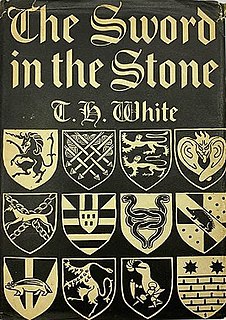
The Sword in the Stone is a 1938 novel by British writer T. H. White. First published by Collins in the United Kingdom as a stand-alone work, it later became the first part of a tetralogy, The Once and Future King. A fantasy of the boyhood of King Arthur, it is a sui generis work which combines elements of legend, history, fantasy and comedy. Walt Disney Productions adapted the story to an animated film, and the BBC adapted it to radio.
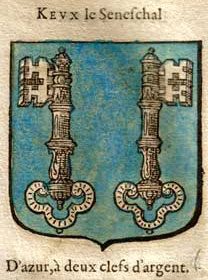
In Arthurian legend, Sir Kay is King Arthur's foster brother and later seneschal, as well as one of the first Knights of the Round Table. In later literature he is known for his acid tongue and bullying, boorish behaviour, but in earlier accounts he was one of Arthur's premier warriors. Along with Bedivere, with whom he is frequently associated, Kay is one of the earliest characters associated with Arthur. Kay's father is called Ector in later literature, but the Welsh accounts name him as Cynyr Ceinfarfog.
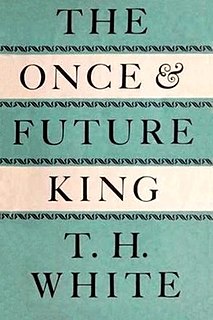
The Once and Future King is a work by T. H. White loosely based upon the 1485 book Le Morte d'Arthur by Sir Thomas Malory. It was first published in 1958. It collects and revises shorter novels published from 1938 to 1940, with much new material.
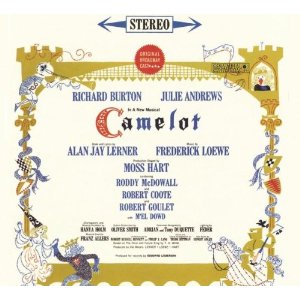
Camelot is a 1960 musical by Alan Jay Lerner and Frederick Loewe (music). It is based on the King Arthur legend as adapted from T. H. White's 1958 novel The Once and Future King.
King Pellinore is the king of Listenoise or of "the Isles" in Arthurian legend. In the tradition from the Old French prose, he is associated with the Questing Beast and is the slayer of King Lot. His many children include the sons Aglovale, Lamorak, and Percival, and the daughter Dindrane.
This is a bibliography of works about King Arthur, his family, his friends or his enemies. This bibliography includes works that are notable or are by notable authors.
The Third Magic (ISBN 0-88899-126-6) is a fantasy novel written by Welwyn Wilton Katz and published by Groundwood Books in 1988. It was for this work that Katz received the Governor General's Literary Award. It is a standalone book 215 pages in length and interweaves the legend of King Arthur within its story.

The Queen of Air and Darkness is a fantasy novel by English writer T. H. White. It is the second book in his series The Once and Future King. It continues the story of the newly crowned King Arthur, his tutelage by the wise Merlyn, his war against King Lot, and also introduces the Orkney clan, a group of characters who would cause the eventual downfall of the king.

The Candle in the Wind is a fantasy novel by British writer T. H. White, the fourth book in the series The Once and Future King. Written in 1940, it was first published in 1958 in the collected edition. It deals with the last weeks of Arthur's reign, his dealings with his son Mordred's revolts, Guinevere and Lancelot's demise, and his perception of right and wrong.
Mordred the Evil or Modred the Evil is a fictional character appearing in American comic books published by Marvel Comics. He is based loosely on the Mordred of Arthurian legend.
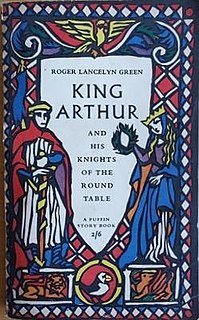
King Arthur and His Knights of the Round Table is a retelling of the Arthurian legends, principally Thomas Malory's Le Morte d'Arthur, by Roger Lancelyn Green. It was intended for a child audience. It was first published by Puffin Books in 1953 and has since been reprinted many times. In 2008, it was reissued in the Puffin Classics series with an introduction by David Almond, and the original illustrations by Lotte Reiniger.

Arthur Rex: A Legendary Novel is a 1978 novel by American author Thomas Berger. Berger offers his own take on the legends of King Arthur, from the heroic monarch's inauspicious conception, to his childhood in bucolic Wales, his rise to the throne, his discovery of the great sword Excalibur, his establishment of the Knights of the Round Table, his long and honorable reign, and his heroic death in battle against the evil Mordred, his bastard son.

King Arthur: Legend of the Sword is a 2017 epic fantasy action-adventure film directed by Guy Ritchie who co-wrote the film with Joby Harold and Lionel Wigram from a story by Harold and David Dobkin, inspired by Arthurian legends. The film stars Charlie Hunnam as the title character and Jude Law as the tyrannical king Vortigern who is attempting to kill him, with Àstrid Bergès-Frisbey, Djimon Hounsou, Aidan Gillen, and Eric Bana in supporting roles.

Daughter of Tintagel is a series of historical fantasy novels by British writer Fay Sampson. It tells the story of the life of Arthurian legend character Morgan le Fay, presented through an oral history narrative from her early childhood to her disappearance. It was originally published as five books between 1989 and 1992, followed by an omnibus edition in 1992. The series was re-published in 2005 as Morgan le Fay.

King Arthur(Arthur Pendragon) is a legendary figure used commonly in comic books.
Merlin is a legendary character who has appeared multiple times throughout comic books especially in DC Comics and Marvel Comics.














